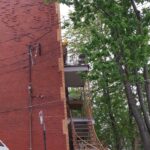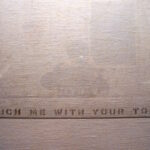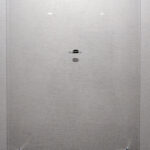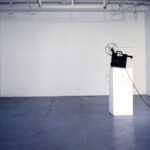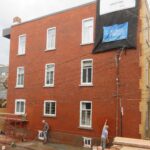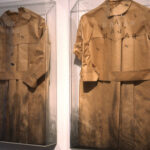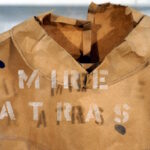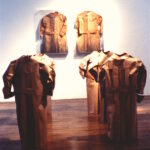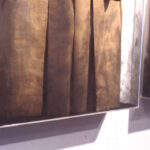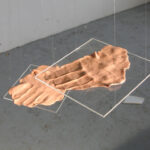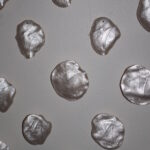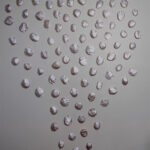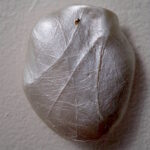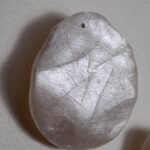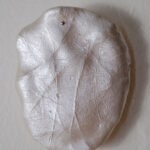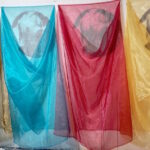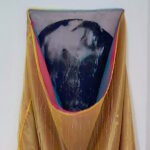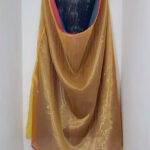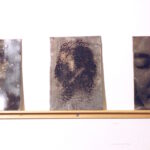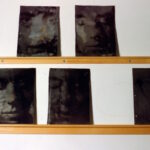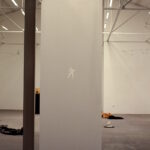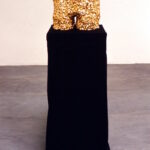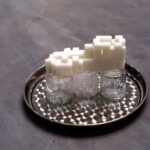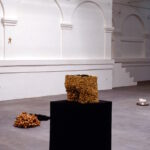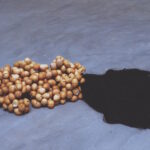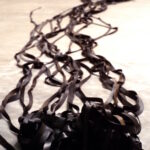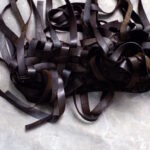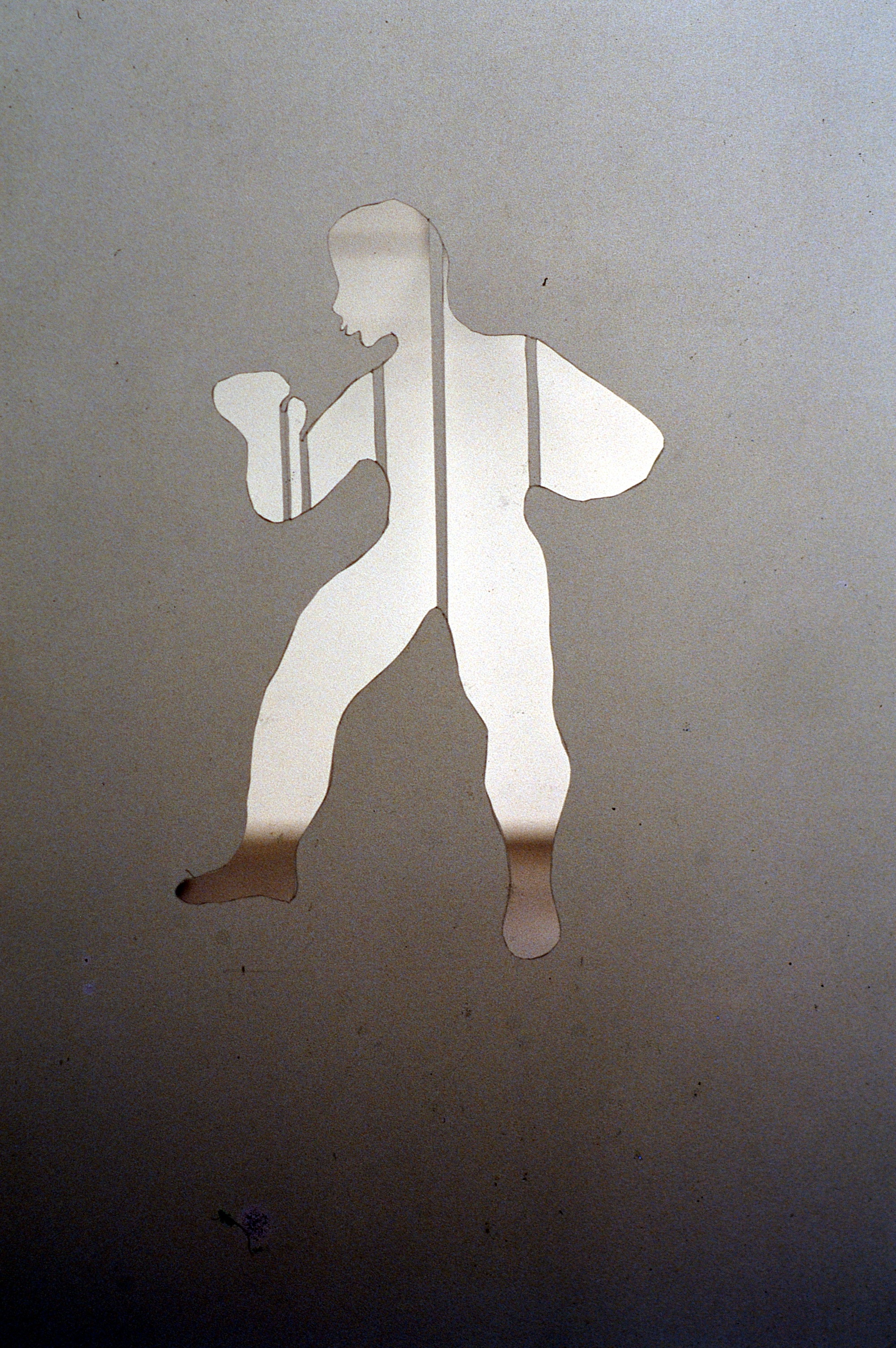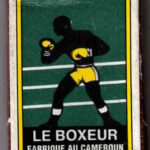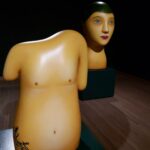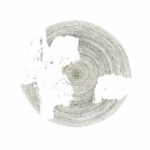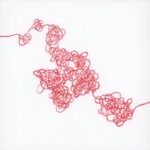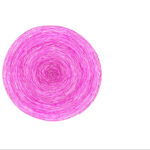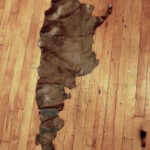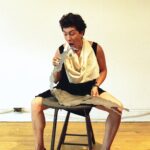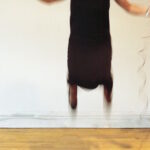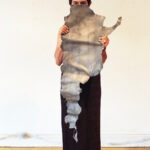Art/Life Blog
About: Art/Life Blog
January 29, 2022This blog is a space to reflect on art, art making and life. It is a way to connect to my day, to myself and to others. It is going to be eclectic and at times autobiographical.
In the Flesh / En chair et en os
At : Produit Rien
6909 rue Marconi, Montréal, H2S 3K2
Vernissage: November 29th, 2023-12 to 5pm
Closing with performance: December 3rd, 2023
Performance: 3pm
About three years, almost 4 years now I started working with Big-Bang, a dance academy in Montreal. I have designed a series of workshops around ideas of performance. The base of the ‘activities’ has been moving with materials and objects that I bring to the participants.
Eventually, it did not take long to think of using my sculpture in the same way. This is part of this research. Léonie Belanger and my daughter Laura Borello-Bellemare joined me in this work, and they brought their on wonderful experience in contemporary dance to the task.
In The Flesh presents six sculptures that find their way into six photographs. The photographs capture women’s bodies wearing, carrying, inhabiting, manipulating the sculptural works. The vulnerability of these bodies, exposed but strong in their framing, proposes an inquisitive narrative exploring the question: what should be done with these objects?
The sculptural pieces in themselves have been an exploration of how to inject symbolic meaning into mass-produced articles, specifically products and materials found in the ubiquitous dollar store, but also in the hardware store, and the notion’s store.
I have transformed the banal domestic objects into sculptural art-works connected to ideas and feelings related to my body and my bodily experiences.
This manipulation and handling of the sculptures by the bodies, tell a story of a deeper connection, which is performative in nature and revelatory of youth and aging; furthermore, it talks of bodies as a source of pleasure and pain, disguise and confrontation. At the end, I see us in the flesh, me and them, able to pose but unable to move, vulnerable but aware of a strength that keeps us looking at ourselves.
……………………………………………………………
En chair et en os
En chair et en os comprend six sculptures qui se retrouvent en six photos. Ces images illustrent des corps féminins qui portent et transportent les pièces sculptées, les habitent et les manipulent. La vulnérabilité de ces corps, à la fois exposés et fortement encadrés, proposent un narratif interrogatif, presqu’inquisiteur : quelle est donc la destinée de ces objets ?
Ces sculptures sont elles-mêmes une tentative d’infuser une signification symbolique à des articles de fabrication industrielle qu’on trouve par exemple aux magasins à un dollar, en quincaillerie ou en mercerie. J’ai transformé ces articles de la banalité domestique en sculptures liées à des idées ou émotions issues de mon propre corps, ou de ses fonctions corporelles.
Le traitement que subissent ces sculptures traduit un lien plus profond, de nature performative et révélatrice de la jeunesse et de la vieillesse. De plus, elles interprètent les corps comme sources de plaisir et de douleur, de déguisement et de confrontation. En somme, je nous vois en en chair et en os, eux et moi, capables de prendre la pose mais incapables d’en sortir; à la fois vulnérables mais conscients de la puissance permettant cette auto contemplation.
Pierre Beaudoin à Produit Rien 2, 3 et 4 novembre 2023
“Regarder le temps passer”
I have this thing about the idea of ‘redemption’ through ‘offering’. A friend of mine told me that all art is offering, so mine was not different from others, hence not a very original concept to hang on to. Still, I like the idea as a conduit to talk about art. I don’t think Pierre is looking for redemption, but still as we all sat with him, being Saturday there seemed to be more of ‘us’; I did feel his offering to us. It felt heavy, but it also felt like a release.
He had limited ‘his’ space with chalk on the floor, creating a path around the large screen with a digital clock, in front of it a chair and in between a rock on the floor. A beautiful stone, pink and oval it looked soft and heavy.
So, ‘we’ felt time passing and we could see it too on the clock. Pierre performed some activities. He walked around on his path; he stood in front of a wall, that had nails placed in a round shape. I think there were nails, there was a hammer on the floor; probably an activity that took place one of the other two days of the performance.
We also saw him take a bag of yellow pencils and placed them on the concrete wall, on specific holes. Were the holes on the wasll from before? Or did he create these holes previously? Suddenly the pencils became arrows, at least to me they seemed to transform.
At another time he took a wooden dowel, he stood placing it on the floor and put it on his mouth, holding the dowel with only his mouth and stood leaning into the object. Eventually, spit starting to fall along the dowel, and it pooled on the floor. It was a way, for me, to show his humanity. I believe bodily fluids, spit, blood, etc. express our humanity. After a few minutes he stopped, and the spit remained in place.
And time passed, and I thought of a wonderful novel by Martin Amis called Time’s Arrow. It is a book that narrates the story of a man, going backwards. In the novel we move from America to Nazi Germany, and everything is narrated backwards where the narrator and the protagonist of the story are not the same.
As we sat with Pierre, time went forward and time and space expanded. I felt I was seeing Pierre sitting further from me, from the beginning of my visit. I had not moved from the same chair. Perception is a tricky thing. As humans, our dilemma is that we can’t go backwards in time, only forward, and that is how we age and move towards our own extinction.
After an hour and a half, I left. The performance was less about redemption and more about offering. The nails and the pencils/arrows on the walls were more about sacrifice. However, he showed us literally time’s texture, and we shared with him, its softness and its inevitability.
It is a work made of crocheted ball chain. Ball chain is a versatile material and crocheting with it created an unusual result. I knitted a closed tubular shape opening up into a flower like shape. The piece can be displayed in various configurations, and can be manipulated.
The work is hermaphrodite, by that I mean that it has both a phallus like shape, the tubular shape mentioned above, and an opening like flower shape mimicking a vulva.
The crocheting refers to traditional domestic feminine activities, but here a non-traditional material is used, one that is found in a hardware store. The viewer is encouraged to manipulate the work, to be able to feel its weight and form it into various shapes.
This piece had never been exhibited in a gallery setting, until November 2023, when it was presented at Produit Rien in the exhibition In the Flesh / En chair et en os.
The work is on a wall of a building by the corner of rue Bibaud and Berrie. Right around the corner from Metro Laurier.
On Wednesday May 4th we did the official opening of my first and only public work. François Bellemare and I worked very hard to create a figurative image of a face on the brick wall of a three-floor building. The face seems to be glancing side ways.
For those who would like to go and take a pick, look up on the rue Bibaud side, right corner of the brick wall on the third floor. The bricks are all the same color; the only difference is the placement of the bricks. Some bricks are protruding half and inch to create a very sublet image. For the time being there is no sign, or sign pointing to the work. This is on the works.
We realized the work would change with the light and the weather. It will be interesting to see it in the winter with snow.
We would like to thank the company that actually took care of the work, Maçonnerie Gratton. They did an incredible job following our directives and design with lots of enthusiasm for the idea.
Found Object, 1993
May 9, 2022Found Object is a piece whose name makes reference to the artist’s find of a shaving blade marketed for women, with the brand named Nymph. The actual packaging stated that it was a ‘lady’s blade’.
The blade is glued on the front of a piece of acrylic about 30 by 42 inches. The pane of acrylic is attached three inches from the wall with metal hardware. The text Touch me with your tongue is etched at the bottom of the acrylic creating a shadow on the wall. Lady’s Blade is written on the wall behind the razor.
The piece functions within a feminist reading of the public and a private spheres. The public voice speaks of a status quo, authoritarian and violent, whose main desire is the molding of woman into submissive, nymph-like creatures. The intimate, private voice is represented by the invitation: Touch me with your tongue, which should be sensual but it is also a violent refusal to conform. Are we invited to touch the blade with our tongues?
Seeing Things, 1992, was part of my final MFA show at Concordia University. The piece was later shown at La Central/Powerhouse.
The work is made out of four elements: a 16 mm projector, and a 16mm film on a loop, the actual projected image on a wall and the presence of an industrial fan turned on. The projector and the fan’s noise are part of the installation. The fan is on looking at the back of the projector and blowing into the projected image.
The Bourget Building where the MFA program was housed at the time had left over old objects around the studios, and the fans were some of them. This is a large industrial standing metal fan with a diameter of approximate 30 inches.
With the help of another student in the program, EA, I had shot a black and white, short 16mm film of myself, just the eyes, blinking as if something was disturbing my vision.
I am particularly fond of this piece as it navigates absence and presence, reality and illusion, fiction and representation.
The eyes are reacting to an exterior force that is taking place in a different time and space.
Invitation au dévoilement d’une œuvre extérieure de
Mariela BORELLO et François BELLEMARE
produite par l’entreprise Maçonnerie Gratton :
“Le regard imbriqué”
mercredi 4 mai 2022 à 17h00
à l’angle des rues Berri et Bibaud (en face de l’école Laurier)
à 45 sec. à pied du métro Laurier (sortie Nord vers rue Laurier)
quartier Plateau Mont-Royal à Montréal.
Prélude:
extrait d’une création de danse contemporaine
par des membres de la troupe Acollectif
ensuite présentée au Festival de la Relève
Merci de faire circuler !
Palomitas Blancas, 1994
(Each uniform: 48 x 18 x 14 inches approx.)
(Each box: 48 x 18 x 6 inches)
Palomitas Blancas (Little White Doves) was produced in Argentina, after I received one of my first creation grants. The work is directly related to my experience of exile. It is probably one of the few pieces that speak in such an autobiographical manner bringing childhood memories and the experience of immigration together. Children wearing the white uniforms would be called in popular vernacular as “Little White Doves”.
The work is made of two sets of uniforms. On the floor a group of six uniforms made out of Kraft paper, life size, standing like in a vigil, in two rows. The uniforms are modeled after the white uniforms used by girls in the public education system, most of the time at the elementary level. I worked from the actual patterns to cut them out and machine sewn them like if I was working with a fabric.
On the wall, placed at eye level, there is a second set of uniforms encased on two acrylic boxes, housing one uniform each. There is powder graphite, inside at the bottom of the boxes, and fingerprints marks on the acrylic. Each box has an etched message on the surface, ‘Mira atras’ and ‘Al bajar’: this translates as ‘Look Behind’ and ‘When You Step Down’. This sign is found on the back door of public city buses to warn people to be careful of potential upcoming traffic; buses would not always stop close to the curve.
I use this sign to speak of history, of how as citizens we must look back continuously at the past if we want to understand our present and our future.
The work speaks of absence and of presence revealing different levels of meaning and of understanding of the experience of violence and immigration.
Lifeline / Línea de vida, 2005-20
Palm reading’s origins are very old, and I have always found it fascinating. The most important lines to be read on a palm are: the line of life, of the heart, of the head and the fate line. For this work I zeroed on the life line by taking the imprint of my left hand palm and reproducing it. In a sense the imprint is the negative of a positive.This work is not part of my site, nor has ever been presented publicly.
The work has gone through different versions. The first was unstable as I used ‘skin’ tone plasticine. I wanted that fragility to come through. I had designed it to be shown on hanging acrylic shelves.
Then I started working with another material that could be baked and make it more stable. This was interesting, now the imprint was fixed. I used smaller round pieces of the material creating a sort of small shell. Interestingly enough I think that was what made some people cringed. It created other references of actual kitsch work, in and around seashells. That reference was not there for me. As I finished painting them silver, they had become something else. The work for me was strengthened by the paint. This last version of the work presents it as an installation, which has each perforated piece, pinned against a wall, creating a funnel shape. Each piece is unique.
The attached documentation shows examples of the two versions of the work.
To have part of my body presented as such is a powerful gesture. This is tied to work I did on fingerprints, on photographing my tongue and my face. All of these are different ways to define identity and self. I do think all of this work comes out of my experience as an immigrant, a continuous definition of the self.
This work was produced following a series of events. On one hand there was a friend with access to a print shop right in the middle of the pandemic. Also, I had been working with dancers, on performance workshops and had brought fabrics for them to work with. Some of the fabric was stretchy, some was semi transparent, and I had gone to a seamstress to join them to create something the dancers could get inside and be able to move. And I had these images of my face from way back; images used on a performance that I thought could work for the prints.
So, we went ahead Stefan and I, and he had the semi transparent fabrics silkscreened with one particular image. I wanted the same image printed, to see how they worked in the different colors. Suddenly the work started to have a life of its own, and I realized I had to overlap the fabrics and voilà! the piece was there. By overlapping the fabrics it created a depth in the image, and it became more than I had planned at the beginning. I ended adding fishing lines to the exterior fabric. The work hangs now at home, in the space facing the stairs to the basement: it has found its place.
I decided to use the words from a Talking Head song as the title.
I want to thank Stefan Hoffmann (printing) and Jennifer Drysdale (photography) for their work.
Growing up (in my hometown of Mendoza, in Argentina) reading was an activity that was natural and encouraged. My parents’ library was the first place I would explore for new titles. My dad had created a system of ‘double’ rows as a way of dealing with his large collection of books, so behind the front row on the shelf, one would find a second. It was not too surprising that at times he had trouble finding certain titles. When we immigrated I remember helping with the boxing of the books. We filled 60 large boxes (the size of 2 liquor cardboard boxes each).
As a kid, I used to read two or three books at the same time. I still do that. My parents made sure I had access to books that were age appropriate, but I always managed to read what I was not supposed to. Like reading dark sexual short stories, or reading about torture in Chile after 1972, or the experience of the bomb in Hiroshima. These were topics no necessarily for an 11 years old kid, but I read them all with keen interest in spite of the horrors I read about, or the early sexual awakening I may have experienced.
We lived in a medium size city that did not have many public libraries. My high school had a very limited and small library. There was a library called the ‘municipal’ library that my father would frequent, a place with no access to the stands, but a card filing system and a librarian over a counter. The public and private universities had libraries too, but at the time I was too young to have access to them.
After the 1976 military coup that took power in Argentina, and a few years of comings and goings between continents, I ended up immigrating to Ottawa to join my parents. I remember how I lived in the library of my high school. Having recently arrived and trying desperately to learn English as fast as I could, I would hang out there and read everything I got my hands on, particularly philosophy.
Then I moved to Toronto having been accepted at OCAD (Ontario College of Art and Design), not yet a university. The college’s library was located in an old extension of the building with large windows looking into Grange Park. I worked there as a student, when Ian Carr-Harris was the director. It had a wonderful ‘image’ collection, which Internet has made obsolete. We were also using a card filing system to look for books; it was the early 80’s after all. Then there was the public library in town. It was the central library on Bloor Street that attracted me.
I attended Guelph University for a couple of semesters after Toronto, which had a big library and music collection too. Two memories from that time at U. of Guelph’s library were of reading le Marquis de Sade and listening to Bach.
In Montreal, my first memories were of the old Webster library at Concordia University, researching on feminist artists as I went through my MFA program in the early 90’s.
Later on, when I became a mother, I remember the pleasure of visiting the Montreal public libraries with the kids, and bringing home two large bags full of books every three weeks. The children’s sections of the Montreal public libraries has toys, which was very convenient, in that way I would get the kids playing while I would look for books. I don’t know who had more fun then. At home, we had reserved two shelves on one of our bookcases for just public library books. In the last few years and now with the kids grown up, a new brunch opened up just a couple of blocks from us. Now, I reserve books on line and thoroughly enjoy getting an email telling me the book is ready to be picked up.
In a sense today’s blog is all about access to books, so I would like to mention a particular bookstore. This was a bookstore from my home city and what I discovered there. My father in the 70’s, pre-Internet time, would order books via regular mail from other bookstores within the country but also directly from Spain or Mexico. He also used to order through a particular bookstore in town: Librería Rovetti. It was own by an Italian man, Rovetti, who had left Italy after the first war world and settled in Mendoza. He spoke Spanish with a thick accent and my father and him would spend hours talking about Italy and the wars.
One time, as in many other times before and after then, I went with my father to the bookstore. The shop was dusty and dark. I remember Rovetti as a very gentle man. My father asked him about books for me, I must have been 11 or 12 at the time. He showed me a couple of shelves, as they continue talking I started looking through the books. Then I found a collection of books that looked interesting: “Ana de los Piñones Verdes”, Anne of the Green Gables. I did not know who she was, but the story looked good. It was a small soft cover Spanish edition (Spanish from Spain), with a tight print, and no illustrations. And I fell in love with Anne, the way a kid can, and came back for more of the books. I remember looking at the map to find P.E.I., thinking how exotic it looked, and so far away.
After my mother left Canada for good to go back to Argentina, ten years after my father’s passing, she left part of what had been my father’s and her book collection. This was a reduced selection my father had shipped to Canada in the late ’70, but of course he kept buying more books. My brother and I were not ready to keep all of these books, so we decided to donate most of them. A particular group of books was sent to a library in Europe that specializes on books connected to Jorge Luis Borges. My dad had written about him and had an extensive library on books of literary criticism on Borges. Another group of books were mainly foreign writer’s novels in Spanish translations that my mother had bought through the years. Those were donated to one of the branches of the Montreal public library that has lots of books in Spanish. The bulk of them, books of fiction in Spanish, were donated to the Spanish Department of the Université de Montréal for their reading room. I was impressed when they showed up with boxes and got to work swiftly and efficiently. A few books my brother and I kept, special editions, first editions and some special books, which included my dad’s own books.
The experience of the power of books is also related with stories of the books that were burned, or buried, or hid. The military regime that took control of the country in seventies, made sure of reinforcing that power by publishing in the local newspapers, lists of books that were considered ‘subversive’ and hence, illegal, and the lists were meant as a warning. Ideas are dangerous in such a political context. For me as a teenager, it spoke volumes of how thinking independently was important, albeit risky. I really have to credit my parents who strongly thought that the individual’s humanity and dignity went beyond and above political parties or ideologies. I learned it by observing how they acted, and how they spoke of others. I am immensely grateful to them for this.
I have not mentioned second hand bookstores, lost books and found books, or books carried in my handbag like an amulet. I just wanted to share a few stories. Now, I keep a small library and renew it and purged it every year, to keep it at a reasonable size. I know they are titles on my shelves that I will never get rid of; such is the power of books.
Mother Tongue/ Lengua Madre, 1991
I produced Mother Tongue 30 years ago (!), towards the end of my MFA at Concordia University. At the time my friend KF and I had created a dark room out of a closet in the Bourgeois building. Under strange administrative reasons during those years, being part of an open graduate program that had no link to an undergraduate one, left us unable to use the darkroom in the VA building, or any other shop for that matter. So, we made our own.
In retrospect it probably was very toxic, and I don’t remember if we used masks, on top I started using ‘liquid light’ on lead, doubling the toxic possibilities probably! KF reminded me a while ago that my experience working in the photo lab at OCAD in Toronto came in handy. I knew what to buy and to how to mix the chemicals for developing and printing black and white.
Mother Tongue is made out of a series of approx. 20 lead panels seven by five inches and about ¼ of an inch thick. As I mentioned, I used liquid light (a chemical that makes any surface light sensitive) to develop black and white photographic images on top of the lead. These panels would sit on wooden ledges; the configuration would vary depending on where it was installed.
The images in the lead pieces are of my face with the eyes close, of my face with the eyes open, of my tongue and of my thumbprint: all elements to confirm identity. The photographic images sat very unevenly on the surface of the lead creating differences with each image.
This work was exhibited at Articule, in Montreal in a group show where three curators had chosen three artists of the community. It travelled to AKA’Artist Centre in Saskatoon as part of a show I had titled ‘Heavy Stitching’, and my friend DB took the work to Mexico along side other works from Montreal artists. Somehow some of the pieces have been ‘lost’, I don’t know how that happened, but I was neglectful to check that they were all there every time the work came back from its travels.
I am particularly found of the work as I think it is one of the strongest works where I combined my feelings of exile tied to my identity as an artist and a woman.
Le boxeur se prépare, ses vêtements attendent dans la salle/
The boxer gets ready, his clothes wait in the room, 1999.
Documentation of this piece can be found in the site under past works, but I felt I wanted to bring this installation to the forefront. It is a work that has stayed with me after all of these years.
François (my husband) and I had at that point been in Cameroon for at least for one year. We had come to central Africa with a contract Francois had obtained with Oxfam Quebec. I was unable to do the same, but I wanted to stay busy and useful. I did volunteer work teaching at two different institutions, a wonderful experience that helped me improve my French on the way.
At the same time, it was important for me to connect with local artists. I reached out to the different art institutions and that included Espace Doual’art, in the city of Douala. Princes Marylin Douala and the late Didier Schaub speared headed Doual’art, a center of the arts, education and communication that had already made a big impact on the city of Douala for the better, and it continues to do so. At one point Doual’art offered me the possibility of presenting my work. Our daughter had already been born, and I produced the whole installation in her company.
The work was inspired by an image of a boxer on a matchbox easily found in the 90’s in Cameroon. The installation is made out of six elements. There are two images of the boxer; one in imitation gold leaf and the second one is a cut out figure at the entrance of the gallery. The other four elements are objects that make direct reference to the boxer’s clothing: a shoe, a boot, a glove and shorts. Every piece in the installation has its own particularity and presence, but each is somehow dysfunctional.
I wanted to use materials easily found in African markets: recycled rubber inner tubing which is used to tied things up, white sugar, egg-shells coming from the local egg production, false hair from the many hairdressing saloons and hand made cut gravel. Ebolowa, the city where we lived, has about 40,000 inhabitants and is located about 1h30h from the capital of Yaounde (and 3 hours from Douala). Outside of the city center, by specific rock sediment, we had encounter adults and children spending their days under a small hut, chipping on the gravel rock with small hammers. They will sell their work to local construction companies.
The activity of making gravel by hand had made an impression on me, and I wanted to use their work in one of the pieces. I bought a few pails of the gravel to build the shorts of the boxer, and then I used imitation gold leaf to cover its exterior. It is the only piece that I placed on a pedestal. All the other works were placed on the floor.
The boot was made of long rubbers pieces that occupied a large space on the floor ending on the actual boot, built by knitting the rubber the rubber pieces, and it is about three feet in length.
The shoe (standard size 10 man) is made of sugar cubes glued together, sitting on a serving tray with water around it.
Further in the gallery, there was a large object close to three feet in length made out of eggshells, with long pieces of dark false hair. It was not obvious but the eggshell object was meant to be one of the boxer’s gloves, with false hair at the end.
As I mentioned before there was an image of the boxer on the wall in front of the installation of about 12 inches in height made out of imitation gold leaf. And as one entered the installation I had hang a long piece of tracing paper and cut out the image of the boxer also of about 12 inches in height.
The day after the opening of the show, the gallery organized a discussion around the work in the presence of the public and many artists of the community. For me at the time, it was an invaluable opportunity to make a deeper connection with local artists; an enriching experience overall.
Every three years or so, since 2007 Doual’art has organized SUD the Salon Urbain de Douala. I was honoured to participate in 2010 with two different shows: an installation at the gallery in January of that year, and then a video projection out side the gallery in December 2010 in the middle of the actual Salon and the other works being presented.
My artwork sits in at least two different storage areas, a basement and my studio. Of course, I also have some at home. I will not stop working but I need to think what does this mean, and how am I going to deal with the artwork as time goes by. I have destroyed some in the past. I have a gifted some, as I moved between provinces. And I did bring some of the pieces with me. I have recently sold some pieces. I felt very lucky to find somebody interested in the work to actually acquire it. But still there is a lot of it. I have thought of recycling the work. But I will not, as I care too much for it.
I may gift more. I could donate some, but this is hard to do. Not everybody wants the work, really. This is work produced from the late 80’s till now. There are boxes and crates and bags. Some work will need to be ditched, I realize now that some pieces are decaying for reasons I will not go into here. The 2-D work is easier to keep, although it is fragile, most of it on paper. The 3-D work is harder to keep and as fragile. Also some work has been made with material that was not meant to last this long.
So after so many years of producing I feel bad to think I will leave all of these works “houseless”. The other part of the conundrum is the work that will never be shown or that will get lost. Re-doing my website has been a wonderful way of creating a virtual space (gallery) for the work. The other thing that I am thinking, and I am in the middle of producing, is to create mini catalogues of individual pieces or of series of works. In that way the documentation will not get lost and the work will exist at least in printed fashion.
I am sharing this, as I don’t think I am not the only one with this kind of problem. It is clear that I will continue to make all sorts of artworks and finding ways to house the work will be critical.
It was time to go back to the museums, so I diligently bought a membership to the MBAM, first time doing so. The MBAM has an offer for what they call a Duo membership; it allows you to invite a friend or family member to come with you. For this occasion I invited a friend to come along with me to see this particular show: Nicolas Party’s L’heure mauve. I was intrigue about the work.
But first things first: the museum itself. There are two things I would like to mention. First, the museum has a ‘check your coat at your own risk’ kind of coat check, which I found a bit strange and dangerous (for my coat). You just place your coat wherever; the options are a couple of coat racks or open boxes against the wall. I opted to stuff my coat in a box in the dark, so people could not see what it was. My friend went to the option of the coat rack in the open. I guess you measure your risk depending on your coat, but I had warned my friend and he dressed accordingly.
Then after we showed our reserved tickets (printed in advanced) and my membership card, we ventured into the stairs. And this is my second issue; you know what I am talking about ‘the stairs’? But maybe you don’t. The ‘new’ wing of the museum on the south side has a set of stairs that take you to a lower area. Of all the stairs I have experienced in my life these are the worst, you feel like you are falling as you go up or down, same disorienting feeling. So, I decided to research on ‘standard’ stairs requirements, and I learned about the ‘riser’ and the ‘tread’: the standard riser is 4 to 7 inches (100-180mm) and the tread should be about 11 inches (280mm). I am guessing this is a North American standard. Although I did not measure them, it feels that the tread of the MBAM stairs is at least 18 inches and the riser is way less than the standard more like 2 to 3 inches. The experience is disconcerting and one has a feeling of continuously losing one’s step. OK, enough of this, and on to the exhibition.
As we entered Nicolas Party’s exhibition L’heure mauve, we quickly realized we were entering the fashionable ‘let the artist pick from our collection to show his/her work along side’ kind of exhibition. The title of the exhibition makes reference to a wonderful painting by Ozias Leduc that is also part of the show. Party is a Swiss artist who works mainly with dry pastels, and whose work is calling a lot of attention in the art’s world. I appreciated the artist’s selections from the collection that called upon ideas of nature and specifically of the Canadian landscape, and that are echoed on his own work. The whole show feels very ‘Pop’ art probably because of the bright/flat colors used. The artist did not only select paintings but he also selected from the large collection of contemporary furniture the museum owns, adding a wonderful playful element to the exhibition.
Of the paintings he selected, Ferdinand Hodler The Wood Cutter (1910), is a very strong piece that seems to be working along side Party’s own painting sensibility. There is also an Otto Dix painting, a work that Party reproduces in part in one of his paintings. We see several Group of Seven and Emily Carr’s paintings among the many chosen. The show covers several rooms including two massive murals, and sculptures in very bright colors. Towards the end of the exhibition we arrived to a painting by the artist that feels like a complete anomaly. Red Forest (2021) is a large ‘naturalistic’ painting of a forest all in reds and blacks with a very sensitive rendition of the trees and the flames. This painting really surprised me as it has a completely different quality of all of the other paintings in the show. Was this work coming out at the end of the artist’s encounter with Canadian landscape painting tradition? We exited the show with a clear feeling that the artist was a genius designer on how he combined his work with the collection, but we could not imagine his work by itself. At least I could not.
In addition to the visual experience, Pierre Lapointe, the Quebec singer-songwriter was asked to create some songs to go along the show. Personally the music does not add anything to the exhibit, but I think it is worth checking it out.
We visited other parts of the museum, re discovering some wonderful works from the museum’s North American collection.
As we climbed the stairs once more, I held tightly to the handrail, planning my next visit to the museum. And yes, my coat was there, wrinkled but in one piece. We also enjoyed an Alex Colville painting, Cyclist and Crow (1969) that is hung among the coats. And we wondered if it was an original work, as it hang in this not so supervised section of the museum.
I have been working with gouache on paper for many years now, at least since the year 2002. I started with a series of spirals. It was a dare to myself to keep working with a brush, I could have switched to markers, but it felt not right. At the time, I taught myself a particular technique whereby I could paint a spiral, keeping it almost perfectly even. The technique requires to paint backwards and to move the paper keeping the hand holding the brush on one place. I kept doing these spirals in all sorts of sizes and colors for many years. I think the more interesting ones were the ones that were white on white.
A few years ago I started to pull away from the spiral into other line work always with the same technique of using a very fine brush on hot pressed watercolor paper. Hot pressed watercolor paper has a very smooth surface and it works wonderfully with the gouache. This time I did a series I called Tangle. The trace of the brush was very thin and they were made of two parallel lines, keeping an equal distance. I did many versions, including a red series: an installation of almost 30 small 8 by 8 inch paper mounted on wood. The meditative quality of the work has become addicted to me now, and I need to do some everyday, no matter what other work I am doing in the studio.
The line work is changing and evolving and I am always experimenting. I also changed my support at one point; I painted on aluminum (large, actual pizza trays 14 inches in diameter) and started using three parallel lines. This took place after seeing Julie Ouellet’s wonderful exhibition a 1700 La Poste last year. Her work is quite different than mine in quality and she works with acrylic paint.
I have gone back to paper and to two lines, from very fine lines I am moving into thicker lines, and work that has different depth and occupies the paper in other ways. Presently, I am working on tracing and vellum paper 19 by 24 inches (110 lbs). It is a challenge to document, but a great pleasure to work on. This latest work is pushing me into unexpected directions.
The places we have lived-in are part of our memories and our imagination. I am talking about the houses and apartments we grew up in, the ones we shared with our friends when we were students, the ones we shared with our children and partner later on in life. We may not visit them in decades, and in some cases we will never see some of them again. These are places that live also in our imagination, and they show up in our dreams sometimes and in our thoughts randomly.
So, I am not sure what was I thinking a few weeks ago when these three works of art popped up in my mind. Suddenly, there was an obvious connection between them. The three works are: Julio Cortázar, House Taken Over (La casa tomada), a short story, 1946; Luis Buñuel, The Exterminating Angel (El angel exterminador), a film , 1962; and Ray Bradbury, The Haunting of the New, a short story from 1969. If you have read the short stories or seen the film, you may have some idea of what I am talking about. The lead protagonist in the three narratives is a house.
Ray Bradbury’s The Haunting of the New is a story that was made into a short film and it is easily accessible on line, although I would recommend reading the short story first. In this story there is a woman who inherits this big castle like mansion, an incredible place with antique furniture, tapestries and candelabras. She hosts lavish parties with famous people in the arts, politics and society in general. The parties would last for days and the guests would give in to all their sexual appetites with the hostess encouragement. Then, the house burns to the ground, and the owner re-builds it exactly as it was. And this is the interesting thing about her reconstruction, as she makes sure the tapestries are the same, as well as the furniture and the decoration. After that, she starts again throwing her parties, but the very first time she does the house rejects them, and pushes everybody out, like a cursed thing it made everybody run away.
In Julio Cortázar, House Taken Over (La casa tomada) a brother and a sister lead a very domestic life in a large house also inherited from their parents. They don’t need to work, as they own land that gives them a comfortable monthly income. The cleaning of the house, and they are very adamant about this, occupies part of their daily activities. However, slowly the house starts to push them out, room by room. The house is being ‘taken over’ by some force. There is no explanation for how, what or who takes over the house. But at the end they must leave their very domestic lives, and they get rid of the key, just in case anybody would have fall prey to the house.
Luis Buñuel, the master of the absurd, presents in his film, The Exterminating Angel, a party of the high bourgeoisie, with elaborate dishes and lots of servants. Right at the beginning of the film we start to get some idea that something is not just right. First, the guests seem to arrive twice to the house. Then, the help cook included start to leave the house even before the dinner is served, excusing themselves with all sorts of personal reasons. The only two servants that remain serve the dinner. A lot of strange things start to happen, and at the end the guests can’t leave the party. They are unable to pass the threshold to the outside and stay, eating what they can, and sleeping whenever they can and their behaviour start to deteriorate. Nobody who has attended the dinner can leave and nobody can enter either. For Buñuel this deterioration showed the ‘real’ face of the ruling class.
This film can be found in its entirety on line. Towards the end of the film, after everybody is able to leave, the ones who had been prisoners in the house attend a mass, and there is a sense that now they are unable to leave the church. However, the film ends with a riot taking place in front of the church with heavy police repression; no reason is given for this ending, in a typical Buñuel filmmaking, all explanations are possible.
I found it rather fascinating, how the narrators of these stories project into the houses an out of this world power; a sort of morality that they believe controls human behaviour. I don’t think any of the places I have lived would hold such power. However it is clear that in my dreams those places always do. And I find myself unable to escape, as if the power of the lived experience remains in the memory of those houses. This could be an explanation; the ‘living’ rubs on the ‘built’ their experiences and desires, transforming the behaviour and the relationship of both parties.
On this cold day of February, speaking of the body, of my body, its feels like I am offering a humble ode to myself. My body keeps going through changes, not very surprising, our bodies change all the time. But in my case the changes were connected to abnormal cells that grew in me and threatened to take over my body. That is cancer: your own body transforming into an alien creature ready to swallow you up from the inside out, in many cases, in silence.
I still don’t know what this blogging is about, but as I speak of my body, a body that is so present in my work, maybe the blogging is about the work. Most of my three-dimensional work relates to ‘the body’ in all sorts of ways.
What do I mean about the body remembering? The body remembers all, pain, pleasure, and everything in between. And I use all of that to create work that has brought me closer in defining experience, particularly the in between feelings and sensations, related to desire and want. And in some ways, later on with the presence of the illness, it has brought me closer in defining the cancer. But the cancer could not be defined so simply after all.
And it is not just the experience of the illness, but also the experience of the treatments. First (and this was my second encounter with breast cancer), I was lucky enough to find it early and then I let modern medicine do its thing on me. The treatments involved chemotherapy, radiation, surgeries and potent drugs with long lists of side effects. The treatments have also change me.
Maybe this blog is just that, on one hand the body remembering and calling me back to myself, and on the other the forgiving part. How can I forgive the betrayal of the body? : My body betraying me. I can’t speak for everybody who has had cancer, every cancer is different and every person is different, emotionally and physiologically. This equation is very complex. But I felt betrayed.
Trying to forgive the body and trying to keep it healthy is a big job, and probably the most important job I have. I have also been told that the cancer is the response of a body that was forgotten, and the illness is a call of attention. Well, it has my attention now.
Today’s blog is just an acknowledgment of the obvious; that minds and bodies leading with our souls are part of everything we do as human beings. And if we can, and we should, we can try to forgive our bodies’ betrayal in illness. Then, try to embrace the changes brought by ageing that will keep happening. And the end of the day, the most important weapon we have for illness and for aging, it is kindness to ourselves.
The Weight of a Nation is a piece that came to fruition during a particular time when I found myself in a shared, but empty and open studio with clean wooden floors and lots of light. The work was produced in part, as the photographs have yet to be printed in the format desired. The piece never found an exhibition space. This is an installation made out of three elements presented simultaneously.
The first element is a series of photographs that I took of myself with my trusted 35 mm Pentax camera and a long shutter release. In the pictures, I am dressed with a long black dress and black suede shoes. The images are ‘performatic’ and show me interacting with a map of Argentina made out of lead.
The second element is the actual map of about one inch in thickness and four feet in length: soft lead and pliable (and probably toxic, in retrospect).
The third element is a video of me carrying the map on my back and walking back and forth in front of a white wall.
The actual installation presents on one hand the life size prints pinned on the walls of the space. In the center of the space is the lead map placed on the floor, and lastly on the wall opposite to the entrance of the space, the audience sees the video projected on a loop.
As an immigrant to this country from the age of eighteen onwards I felt then, and maybe now too, the ‘weight’ of my country of origin in a literal way. The photographs show a love affair relationship that is simultaneously painful, funny, sexy and heavy to carry. And carrying it I do as an immigrant, the country of my birth is always present in a visceral way.
A New Year: A Promise Kept, Maybe.
February 1, 2022A new year is like a promise to myself, to oneself. Can I keep the promise? I can’t speak for everybody but the ones who are like me. We make unspoken promises, and we whisper them to our pillows, under the shower, getting dressed. We don’t want to speak them out loud; as maybe, probably, we will not keep them.
And then, if we would have spoken them out loud to ourselves, those promises will be stuck on our bathroom walls, or on our mirrors. Or we will find them on our plate, before we serve ourselves some cold pasta from the day before: promises staring at us full of regrets.
And we don’t want that, no, no and no, we don’t want that, it would fill us with guilt and unfulfilled emotions. So, we don’t. We don’t say anything; we keep them in our hearts and minds.
But I think we should, we should take these first weeks of January and speak these promises out loud. Speak out loud these love letters to ourselves telling ourselves promises of a better us, of a better day, a better hour. Whispering out loud promises of new work in the studio, of more loving connections, and of sharing the work. We are what we do everyday, I have been told.
Let’s shout our promises in this new year, a year that has started very much like the last one, with Covid-19 still in our lives. So, we can promise to be outside more, to dance in the snow if we want to, and to love more. These are not hard promises to keep. There are many others that will be challenging and demanding and even painful. But maybe those would make us taller and a bit wiser. And maybe, just maybe 2022 could be the year of promises kept.

